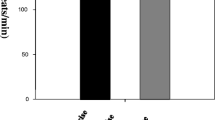Summary
Six marathon runners (T; VO2max 65.7±2.0 ml/kg·min) and 6 sports students (S; VO2max 54.0±2.6 ml/kg·min) were investigated during training specific exercise (graded treadmill ergometric test; TE), non-training specific exercise (graded bicycle ergometric test supine, BE), and following isoproterenol stimulation (2 and 4 µg/min). DuringTE, dopamine (DA), noradrenaline (NA), adrenaline (A), lactate, heart rate, and oxygen uptake were determined. Measurements of DA, NA, A, lactate, heart rate, stroke volume (two dimensions echocardiographic system), and cardiac output were made duringBE. During isoproterenol stimulation, heart rate, stroke volume, cardiac output, as well as glucose, lactate, free fatty acids, and glycerol responses in the blood were measured. NA, A (less significant), lactate, heart rate were significantly lower in T than in S at identical, absolute, submaximal exercise level duringTE. The individuall submaximal NA (r=−0.78), A (r=0.63), lactate (r=0.78), and heart rate responses (r=−0.82) correlated inversely with the VO2max. DuringBE, these training dependent effects werenot well defined, except for the heart rate (significantly lower in T), and stroke volume (significantly higher in T at the 100 watt level). DA did not show significant training related differences during TE or BE. In the isoproterenol stimulation test, stroke volume, glucose, and free fatty acids levels increase significantly more in T than in S. The individual stroke volume increase correlated with the VO2max (r=0.75). The results may be indicative at the one hand of a training dependent reduction of sympathetic activity, and on the other hand of a training related increase of sensitivity for sympathetic stimulation.
Similar content being viewed by others
Literatur
Bieger W, Zittel R, Zappe H, Weicker H (1982) Einfluß körperlicher Aktivität auf die Katecholamin-Rezeptoraktivität. Dtsch Z Sportmed 33:249
Da Prada M, Zürcher G (1976) Simultaneous radioenzymatic determination of plasma and tissue adrenaline, noradrenaline and dopamine within the fentomole range. Life Sci 19:1161–1174
Dickhuth HH, Simon G, Nause A, Korsten-Reck U, Staiger J, Keul J (1980) Linksventrikuläre Größenverhältnisse und Schlagvolumenbestimmung mit dem zweidimensionalen Echokardiogramm bei Sportlern und Untrainierten. In: Kindermann W, Hort W (eds) Sportmedizin für Breiten- und Leistungssport. Demeter, Gräfelfing, S 209–212
Eggstein H, Kreutz FH (1966) Eine neue Bestimmung der Neutralfette im Blutserum und Gewebe. I. Prinzip, Durchführung und Begrenzung der Methode. Klin Wochenschr 44:262–267
Ekblom B, Kilbom A, Soltysiak J (1973) Physical training, brady-cardia and autonomic nervous system. Scand J clin Lab Invest 32:251–256
Hartley LH, Mason JW, Hogan RP, Jones LG, Kotchen TA, Mougey EH, Wherry FE, Pennington LL, Ricketts PT (1972) Multiple hormonal responses to graded exercise in relation to physical training. J Appl Physiol 33:602–606
Hohorst HJ (1962) L-(+)-Laktat. Bestimmung mit Laktatdchydrogenase und DPN. In: Bergmeyer HU (ed) Methoden der enzymatischen Analyse. Verlag Chemie, Weinheim, S 266–277
Kather H, Simon B (1981) Adrenozeptor of the alpha-2-subtype mediating inhibition of the human fat cell adenylate cyclase. Eur J Clin Invest 11:111–114
Keul J, Linet N, Eschenbruch E (1968) The photometric autotitration of free fatty acids. Z Klin Chem Klin Biochem 6:394–398
Keul J, Dickhuth HH, Simon G, Lehmann M (1981) Effect of static and dynamic exercise on heart volume, contractility, and left ventricular dimensions. Circ Research 48:162–170
Le Blanc J, Boulay M, Dulac S, Jobin M, Labrie A, Rousscau-Migneron S (1977) Metabolic and cardiovascular responses to norepinephrine in trained and nontrained human subjects. J Appl Physiol 42:166–173
Le Blanc J, Vallieres J, Vachon C (1972) Beta-receptor sensitization by repeated injections of isoproterenol and by cold adaption. Am J Physiol 222:1043–1046
Lehmann M, Keul J, Huber G, Da Prada M (1981) Plasma catecholamines in trained and untrained volunteers during graduated exercise. Int J Sports Med 2:143–147
Lehmann M, Keul J, Huber G, Bachl N, Simon G (1981) Alters- und belastungsbedingtes Verhalten der Plasmactatecholamine. Klin Wochenschr 59:19–25
Lehmann M, Keul J, Korsten-Reck U, Fischer H (1981) Einfluß der Ergometerarbeit im Liegen und Sitzen auf die Plasmacatecholamine, metabolischen Substrate sowie Sauerstoffaufnahme und Herzfrequenz. Klin Wochenschr 59:1237–1242
Lehmann M, Keul J, Berg A, Stippig S (1981) Plasmacatecholamine und metabolische Veränderungen bei Frauen während Laufbandergometrie. Eur J Appl Physiol 46:305–315
Lehmann M, Keul J, Korsten-Reck U (1981) Einfluß einer stufenweisen Laufbandergometrie bei Kindern und Erwachsenen auf die Plasmacatecholamine, die aerobe und anaerobe Kapazität. Eur J Appl Physiol 47:301–311
Pavlik G, Frankl R (1975) Sensitivity to catecholamines and histamine in the trained and in the untrained human organism and sensitivity changes during digestion. Eur J Appl Physiol 34:199–204
Péronnet F, Cléroux J, Parrault H, Cousineau D, de Champlain J, Nadeau R (1981) Plasma norepinephrine response to exercise before and after training in humans. J Appl Physiol 51:812–815
Sarnoff SJ, Braunwald E, Welch GH jr, Case RB, Stainsby WN, Macruz R (1958) Hemodynamic determinants of oxygen consumption of the heart with special reference to the tension-time index. Am J Physiol 192:148
Slein MW (1962) D-Glukose, Bestimmung mit Hexokinase und Glukose-6-Phosphat-Dehydrogenase. In: Bergmeyer HN (ed) Methoden der enzymtischen Analyse. Verlag Chemie, Weinheim, S 117–123
Stone LH (1977) The unanaesthetized instrumented animal preparation. Med Sci Sports 9:253–261
Tipton CM, Matthes RD, Tcheng TSE-KIA, Dowell RT, Vailas AC (1977) The use of the Langendorff preparation to study the bradycardia of training. Med Sci Sports 9:220–230
Winder WW, Hagberg JM, Hickson RC, Ehsani AA, McLane JA (1978) Time course of sympathoadrenal adaption to endurance exercise training in man. J Appl Physiol 45:370–374
Author information
Authors and Affiliations
Additional information
Mit Unterstützung des Bundesinstitutes für Sportwissenschaft, Köln-Lövenich
Rights and permissions
About this article
Cite this article
Lehmann, M., Dickhuth, H.H., Stamer, S. et al. Unterschiedliche kardiale und metabolische Isoproterenoleffekte in Abhängigkeit vom Trainingszustand. Klin Wochenschr 61, 567–575 (1983). https://doi.org/10.1007/BF01486847
Received:
Accepted:
Issue Date:
DOI: https://doi.org/10.1007/BF01486847




